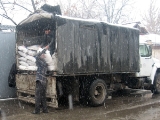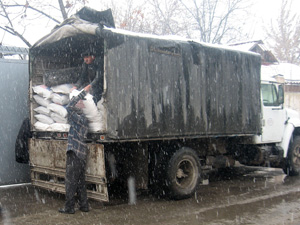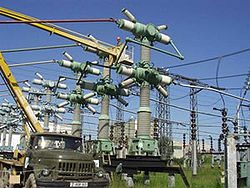
2008 Central Asia energy crisis
Encyclopedia

Central Asia
Central Asia is a core region of the Asian continent from the Caspian Sea in the west, China in the east, Afghanistan in the south, and Russia in the north...
, which, combined with the severe weather of the 2007-08 winter
Winter
Winter is the coldest season of the year in temperate climates, between autumn and spring. At the winter solstice, the days are shortest and the nights are longest, with days lengthening as the season progresses after the solstice.-Meteorology:...
(the coldest since 1969) and high prices for food and fuel, has caused considerable hardship for many. The abnormally cold weather has pushed demand up for electricity
Electricity
Electricity is a general term encompassing a variety of phenomena resulting from the presence and flow of electric charge. These include many easily recognizable phenomena, such as lightning, static electricity, and the flow of electrical current in an electrical wire...
, exacerbating the crisis. The situation is most dire in Tajikistan
Tajikistan
Tajikistan , officially the Republic of Tajikistan , is a mountainous landlocked country in Central Asia. Afghanistan borders it to the south, Uzbekistan to the west, Kyrgyzstan to the north, and China to the east....
. An international appeal has been made by the United Nations
United Nations
The United Nations is an international organization whose stated aims are facilitating cooperation in international law, international security, economic development, social progress, human rights, and achievement of world peace...
, NGOs, and the Red Cross and Red Crescent for around US$25 million to assist the government. The crisis has been ongoing and the UN has warned that millions face starvation during the 2008-09 winter.
Tajikistan
TajikistanTajikistan
Tajikistan , officially the Republic of Tajikistan , is a mountainous landlocked country in Central Asia. Afghanistan borders it to the south, Uzbekistan to the west, Kyrgyzstan to the north, and China to the east....
has the greatest capacity for hydroelectric power in the region (over 300 terawatt-hours (TWh) annually), but during the winter it is often dependent on importing electricity
Electricity
Electricity is a general term encompassing a variety of phenomena resulting from the presence and flow of electric charge. These include many easily recognizable phenomena, such as lightning, static electricity, and the flow of electrical current in an electrical wire...
from Turkmenistan
Turkmenistan
Turkmenistan , formerly also known as Turkmenia is one of the Turkic states in Central Asia. Until 1991, it was a constituent republic of the Soviet Union, the Turkmen Soviet Socialist Republic . Turkmenistan is one of the six independent Turkic states...
and Uzbekistan
Uzbekistan
Uzbekistan , officially the Republic of Uzbekistan is a doubly landlocked country in Central Asia and one of the six independent Turkic states. It shares borders with Kazakhstan to the west and to the north, Kyrgyzstan and Tajikistan to the east, and Afghanistan and Turkmenistan to the south....
in no small part because the water
Water
Water is a chemical substance with the chemical formula H2O. A water molecule contains one oxygen and two hydrogen atoms connected by covalent bonds. Water is a liquid at ambient conditions, but it often co-exists on Earth with its solid state, ice, and gaseous state . Water also exists in a...
used for hydroelectricity freezes, and demand increases. However, because of shortages in those countries as well, electricity supplies have been severely restricted. Furthermore, Uzbekistan cut natural gas
Natural gas
Natural gas is a naturally occurring gas mixture consisting primarily of methane, typically with 0–20% higher hydrocarbons . It is found associated with other hydrocarbon fuel, in coal beds, as methane clathrates, and is an important fuel source and a major feedstock for fertilizers.Most natural...
supplies to Tajikistan on January 24 for payment delays. The amount of water in the reservoir
Reservoir
A reservoir , artificial lake or dam is used to store water.Reservoirs may be created in river valleys by the construction of a dam or may be built by excavation in the ground or by conventional construction techniques such as brickwork or cast concrete.The term reservoir may also be used to...
s is at a record low. The giant Nurek reservoir
Nurek Dam
The Nurek Dam is an earth fill embankment dam on the Vakhsh River in the central Asian nation of Tajikistan. Construction of the dam began in 1961 and was completed in 1980, when Tajikistan was still a republic within the Soviet Union. At it is currently the tallest dam in the world...
has fallen to six meters, a worryingly low level according to energy sector representatives. Snowmelt to replenish the reservoirs is not expected until late March or April.
World Bank debt and price hikes

World Bank
The World Bank is an international financial institution that provides loans to developing countries for capital programmes.The World Bank's official goal is the reduction of poverty...
." According to an official at Barqi Tojik
Barqi Tojik
Barqi Tojik is a national integrated power company of Tajikistan. Chairman of the company is Abdullo Yorov....
, a national power company, limits will become stricter, and the price for electricity is expected to rise until 2010.
On April 2008, Pradeep Mitra, World Bank chief economist for Europe and Central Asia, issued an uncharacteristic statement, urging the worse-hit countries to spend more on social assistance and "top up" their social programs.
Nonetheless, Mitra focus remained centred "on inflation management," suggesting that the affected countries "especially refrain from imposing controls on trade" (measures recently undertaken by many countries to protect their populations from food price inflation and keep food available domestically), arguing that "it could work against the food supply in the longer term."
Power shortages
As of January 13, 2008, many villages received only one to three hours of electricity per day, and the capital DushanbeDushanbe
-Economy:Coal, lead, and arsenic are mined nearby in the cities of Nurek and Kulob allowing for the industrialization of Dushanbe. The Nurek Dam, the world's highest as of 2008, generates 95% of Tajikistan's electricity, and another dam, the Roghun Dam, is planned on the Vakhsh River...
cut power to residential areas overnight. On January 26, 2008, Dushanbe cut power to places of entertainment (including restaurant
Restaurant
A restaurant is an establishment which prepares and serves food and drink to customers in return for money. Meals are generally served and eaten on premises, but many restaurants also offer take-out and food delivery services...
s, shops, pharmacies, markets, and public bathhouses
Public bathing
Public baths originated from a communal need for cleanliness. The term public may confuse some people, as some types of public baths are restricted depending on membership, gender, religious affiliation, or other reasons. As societies have changed, public baths have been replaced as private bathing...
), causing many to close until spring. The few visible lights are from the owners of generators
Electrical generator
In electricity generation, an electric generator is a device that converts mechanical energy to electrical energy. A generator forces electric charge to flow through an external electrical circuit. It is analogous to a water pump, which causes water to flow...
, factories
Factory
A factory or manufacturing plant is an industrial building where laborers manufacture goods or supervise machines processing one product into another. Most modern factories have large warehouses or warehouse-like facilities that contain heavy equipment used for assembly line production...
, or people who have illegally tapped the power lines. The restriction was set to end February 10, but there is discussion of extending it. The only exemptions to the restrictions are for government offices, hospital
Hospital
A hospital is a health care institution providing patient treatment by specialized staff and equipment. Hospitals often, but not always, provide for inpatient care or longer-term patient stays....
s, and certain industrial cities, such as Tursunzoda, which has a large aluminum plant. Because of inoperable central heating systems in Dushanbe and other cities, residents in apartment blocks have no means other than electricity to heat their homes.
Harsh winter
The situation was exacerbated by the cold winter, with temperatures reaching -20 degrees Celsius. Dushanbe residents report wearing several jackets and overcoats to sleep and all family members sleeping under a single blanket to share warmth. The UN's World Food ProgrammeWorld Food Programme
The World Food Programme is the food aid branch of the United Nations, and the world's largest humanitarian organization addressing hunger worldwide. WFP provides food, on average, to 90 million people per year, 58 million of whom are children...
also declared the food situation one of emergency shortage, in both cities and rural areas.
Allegations of media suppression
As of mid-January, the state-run media did not discuss the problem. Subsequently throughout the month of February, there emerged numerous Western media reports of children dying in maternity wards of hospitals during blackouts. The Tajik government maintains that the blackouts were not responsible for any deaths. The Tajik government has appealed for international aid. Meanwhile, aid workers and diplomats urged the government to declare a state of emergency. The handling of the crisis has raised questions about the competence of the political leadership.Famine warning
According to the weblog news service neweurasiaNeweurasia
neweurasia is a network of weblogs about Central Asia and the Caucasus. neweurasia's central idea has revolved around "bridge blogging", enlisting bloggers who speak both English and local languages to serve as links between the English and local-language blogging communities...
, as of March 3, 2008 the crisis in Tajikistan has eased: "From now on (at least till the next winter) Dushanbe is not going to have problems with electricity and the tough schedule introduced in the beginning of this winter was abandoned on March 1, 2008 in Dushanbe by the decision of Barqi Tojik." The Christian Science Monitor, neweurasia, and other media observers are predicting that a nascent hunger crisis will erupt into a full famine
Famine
A famine is a widespread scarcity of food, caused by several factors including crop failure, overpopulation, or government policies. This phenomenon is usually accompanied or followed by regional malnutrition, starvation, epidemic, and increased mortality. Every continent in the world has...
as a consequence of the energy shortages. UN experts announced on 10 October that almost one-third of Tajikistan’s 6.7 million inhabitants may not have enough to eat for the winter of 2008-09.
Kyrgyzstan

Kyrgyzstan
Kyrgyzstan , officially the Kyrgyz Republic is one of the world's six independent Turkic states . Located in Central Asia, landlocked and mountainous, Kyrgyzstan is bordered by Kazakhstan to the north, Uzbekistan to the west, Tajikistan to the southwest and China to the east...
, also rich in hydroelectric resources, the cold weather has made demand 10% higher than the same time last year, which is depleting the main Toktogul
Toktogul
Toktogul is an urban-type settlement in the Jalal-Abad Province of Kyrgyzstan. There are an estimated 15,943 inhabitants. It is named after its most famous son - the musician Toktogul Satilganov. It is located on the northern shore of the Toktogul reservoir. To the south, highway M41 curves around...
reservoir for hydroelectric power.
Uzbekistan
Beginning in late December 2007, the unusually harsh weather has frozen the gas supply to numerous homes and businesses across Uzbekistan. As a result, there have been numerous demonstrations and protests against the government, in favor of an insured uninterrupted supply of gas and electricity. The government response has varied; in Karakalpakstan, they met protesters and promised to rectify the situation, while the local government head of Hazarasp responded to a complaint by one woman by cutting off gas altogether to all the houses on her street.Some in Uzbekistan have turned to "traditional methods" for heating, and there are reportedly some villages which have no tree
Tree
A tree is a perennial woody plant. It is most often defined as a woody plant that has many secondary branches supported clear of the ground on a single main stem or trunk with clear apical dominance. A minimum height specification at maturity is cited by some authors, varying from 3 m to...
s left, because villagers have cut them down to heat their homes and cook food. This is expected to have a negative effect on the economy, because the leaves are essential to the local silk
Silk
Silk is a natural protein fiber, some forms of which can be woven into textiles. The best-known type of silk is obtained from the cocoons of the larvae of the mulberry silkworm Bombyx mori reared in captivity...
industry, and the fruit
Fruit
In broad terms, a fruit is a structure of a plant that contains its seeds.The term has different meanings dependent on context. In non-technical usage, such as food preparation, fruit normally means the fleshy seed-associated structures of certain plants that are sweet and edible in the raw state,...
grown is the main source of income for many villagers.
Turkmenistan
In some provinces of TurkmenistanTurkmenistan
Turkmenistan , formerly also known as Turkmenia is one of the Turkic states in Central Asia. Until 1991, it was a constituent republic of the Soviet Union, the Turkmen Soviet Socialist Republic . Turkmenistan is one of the six independent Turkic states...
, villagers have been burning saxaul
Haloxylon ammodendron
The saxaul, black saxaul, sometimes sacsaoul or saksaul , is a plant belonging to the Amaranthaceae.-Description:The saxaul ranges in size from a large shrub to a small tree, 2-8 m tall. It has a brown trunk 4-10 cm in diameter. The wood is heavy and coarse and the bark is spongy and water-soaked...
plants, a traditional Turkmen
Turkmen people
The Turkmen are a Turkic people located primarily in the Central Asian states of Turkmenistan, Afghanistan, and northeastern Iran. They speak the Turkmen language, which is classified as a part of the Western Oghuz branch of the Turkic languages family together with Turkish, Azerbaijani, Qashqai,...
way to heat homes, but which is a rare plant at risk of extinction. In cities, the central heating pipes have been neglected and do not work well to heat, and electrical devices cannot be used because of a shortage of electricity.
See also
- 2008 Bulgarian Energy Crisis2008 Bulgarian energy crisisThe 2008 Bulgarian Energy Crisis was a crisis in Bulgaria. The crisis affected more than a million households mainly in in the capital Sofia but also in Burgas, Pleven, and Vratsa. As of late September 2008, the issue was not resolved.-Background :...
- Energy crisisEnergy crisisAn energy crisis is any great bottleneck in the supply of energy resources to an economy. In popular literature though, it often refers to one of the energy sources used at a certain time and place, particularly those that supply national electricity grids or serve as fuel for vehicles...
- 2000s commodities boom2000s commodities boomThe 2000s commodities boom is the rise in many physical commodity prices which occurred during the decade of the 2000s , following the Great Commodities Depression of the 1980s and 1990s...
- Global storm activity of 2008Global storm activity of 2008Global storm activity of 2008 profiles the major worldwide storms, including blizzards, ice storms, and other winter events, from January 1, 2008 to December 31, 2008...
- Global storm activity of 2007Global storm activity of 2007Global storm activity of 2007 profiles the major worldwide storms, including blizzards, ice storms, and other winter events, from January 1, 2007 to December 31, 2007...

